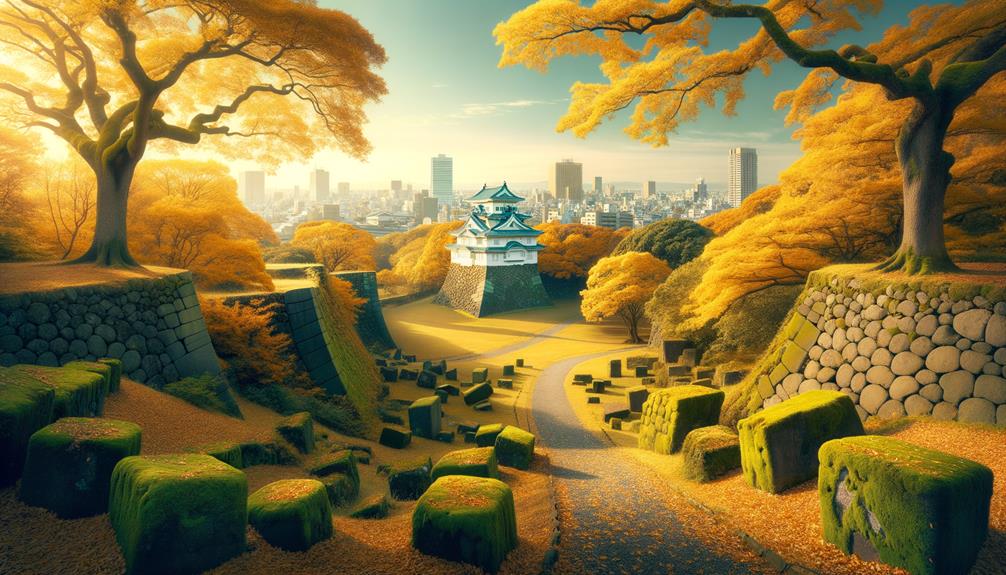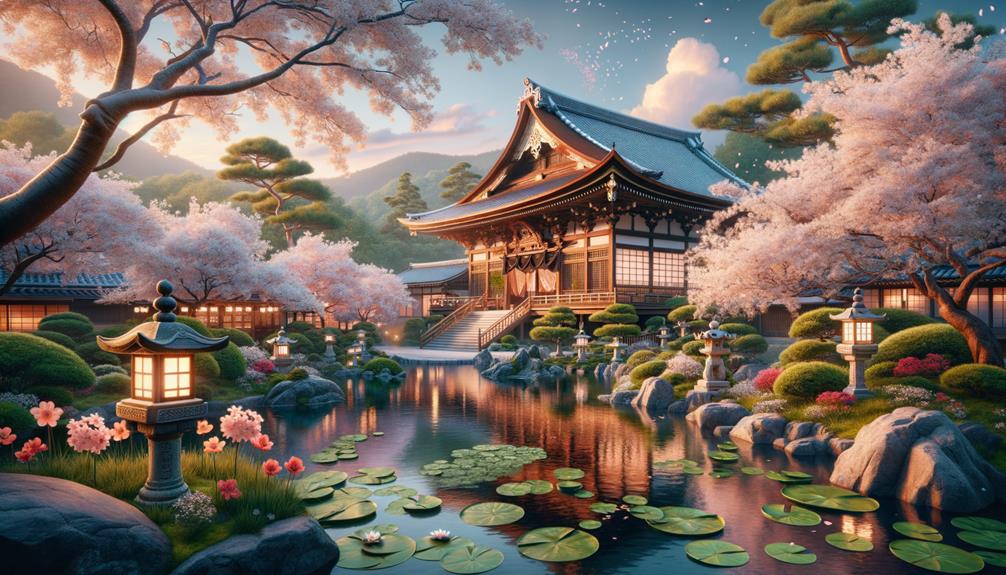Walking through the Sendai Castle Ruins feels like stepping back into the Edo period. As I meandered among the stone foundations and walls, I was struck by Date Masamune's strategic brilliance. The peaceful atmosphere, highlighted by a solemn shrine for war dead, encourages quiet reflection. And then there's the view—stunning glimpses of Sendai city framed by lush greenery. It feels almost otherworldly, making me think about how history and nature blend so seamlessly here. But what stood out to me the most was…
Getting to Sendai Castle
Climbing up to the Sendai Castle Ruins might be a bit of a challenge, but it's a journey worth every step. I started out from Sendai Station, which was buzzing with activity. From there, you can either take the Loople sightseeing bus for a relaxed ride or, if you're up for some adventure like I was, hop on the subway to International Center Station and walk the last 25 minutes uphill.
The climb is pretty refreshing, with each step getting you closer to the historical essence of Sendai. As you go up, the city's noise dwindles, replaced by the sounds of rustling leaves and chirping birds. The path is well-marked, so it's easy to find your way. I enjoyed watching the modern cityscape slowly transition into a more peaceful, natural setting, blending the old with the new.
When I finally reached the top, the panoramic views of Sendai were simply stunning. The castle ruins are a testament to Date Masamune's strategic brilliance and offer a serene escape from the city's hustle. The effort to get there made the experience even more rewarding.
Historical Background
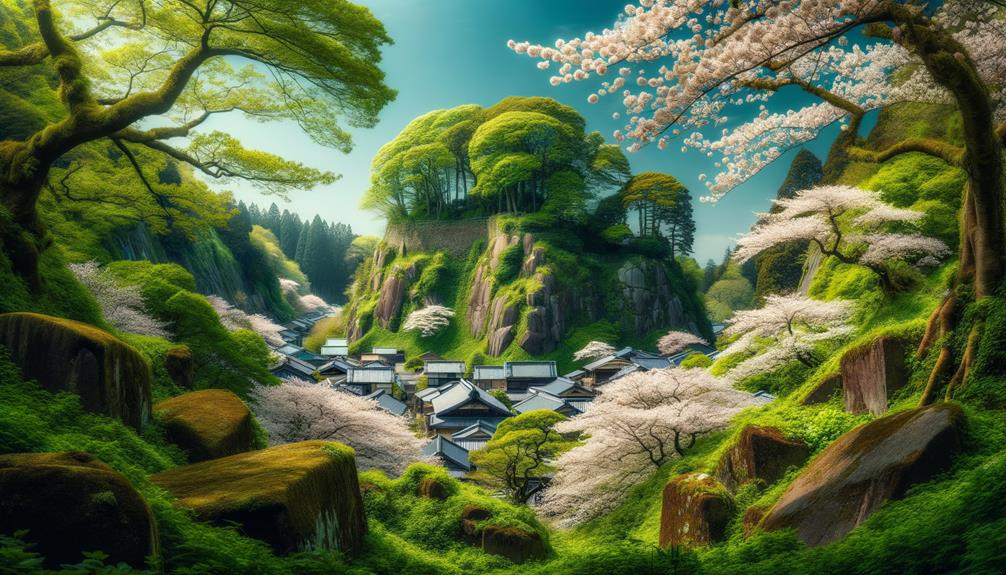
Perched on a hill, the Sendai Castle Ruins were once the grand residence of Date Masamune, a notable figure in Japan's Edo period. This spot wasn't chosen just for the fantastic views; it was a brilliant defensive strategy. From here, Date Masamune could oversee the entire surrounding area, showcasing his military expertise and foresight.
As I walk through the ruins, I can't help but feel a connection to the past. Stone markers outline where rooms and defensive structures once stood, each with its own story. It's fascinating to think that warriors once patrolled these grounds and the castle was alive with activity during the Edo period. Even though most of the buildings have been lost to time, the foundations remain, quietly sharing tales of a bygone era.
The tranquility of the site is almost meditative. The shrine dedicated to war dead serves as a poignant reminder of the sacrifices made. This place isn't just a historical site; it's a cultural landmark that continues to attract visitors seeking both reflection and inspiration. It's a testament to how Date Masamune's legacy still influences the landscape of Sendai today.
Key Architectural Features
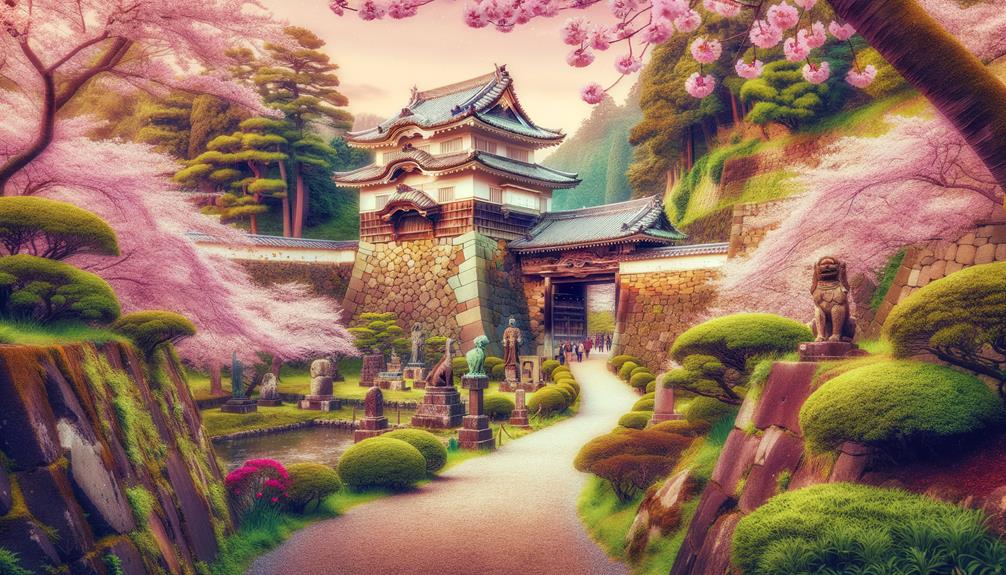
Wandering through the Sendai Castle Ruins, I was struck by the original stone foundations and solid defensive structures that have lasted through the years. The views of Sendai city from the castle grounds were breathtaking and made it clear why this site was so strategically important. Walking among the marked stones and the well-kept layout gave me a real sense of connection to the Edo period and Date Masamune's legacy.
Defensive Structures Overview
Walking through the Sendai Castle Ruins, I can't help but marvel at the carefully crafted stone foundations and defensive walls that highlight the strategic skill of Edo-period architects. These remnants of Sendai Castle's defensive structures are more than just relics; they are a testament to the military expertise of Date Masamune and his architects. The stone foundations, still visible today, outline the castle's original layout, marking different rooms and essential sections.
As I trace these stone pathways, I imagine how these walls once stood tall, offering protection and a commanding view over the surrounding landscape. Though weathered by time, the defensive walls still reflect their strategic importance, showcasing an impressive blend of functionality and aesthetics. Each stone, meticulously placed, tells a story of a bygone era where every element was designed for both defense and resilience.
These structures provide a fascinating glimpse into the architectural and military strategies of the Edo period. They reveal a time when castles were not just royal residences but fortresses designed to withstand sieges and protect their inhabitants. Reflecting on these ruins, I feel a deep appreciation for the historical and cultural significance embedded in every stone of Sendai Castle.
Historical Foundations Display
Standing on the original stone foundations of Sendai Castle, I'm struck by the intricate architectural details showcasing the brilliance of Edo-period design. The well-maintained castle grounds highlight the strategic genius of Date Masamune, the legendary founder of Sendai. Each stone tells a story, offering a tangible connection to the past.
As I explore the foundations, I notice the precision in the placement of rooms and defensive structures. Though worn, the stones remain resilient, echoing the strength of the castle that once stood here. A nearby shrine dedicated to war dead adds a solemn touch, reminding us of the sacrifices made throughout history.
Here's a summary of the key architectural features:
| Feature | Description |
|---|---|
| Stone Foundations | Original, well-maintained, showcasing room layouts |
| Defensive Structures | Intricately designed, strategically placed |
| Shrine | Dedicated to war dead, solemn atmosphere |
| Castle Layout | Reflects Date Masamune's strategic acumen |
| Architectural Precision | Intricate details of Edo-period design |
Walking these grounds, I feel a deep connection to the ingenuity and resilience of past generations. Each step is a journey through time, offering insights into the cultural and historical significance of the Sendai Castle ruins.
Panoramic Viewpoints Highlights
Standing at the panoramic viewpoints of the Sendai Castle Ruins, I can't help but be amazed by the expansive views of Sendai city. The ruins offer a serene and grand setting, making it easy to picture the castle in its glory days.
As I walked through the site, I saw the old foundations of the castle buildings and defensive structures. Stone markers outline different rooms and historical design elements, giving a glimpse into what life was like within these walls. A shrine dedicated to war dead adds a solemn touch, deepening the cultural experience.
One of the standout features is the statue of Masamune Date on horseback. More than just a popular photo spot, it honors the samurai lord who founded Sendai. With the city as a backdrop, the statue captures the lasting legacy of Masamune Date and the castle.
The viewpoints provide a peaceful atmosphere, ideal for leisurely walks and soaking in the scenic beauty. Each step feels like a journey through time, blending history with stunning landscapes.
Exploring the Museum
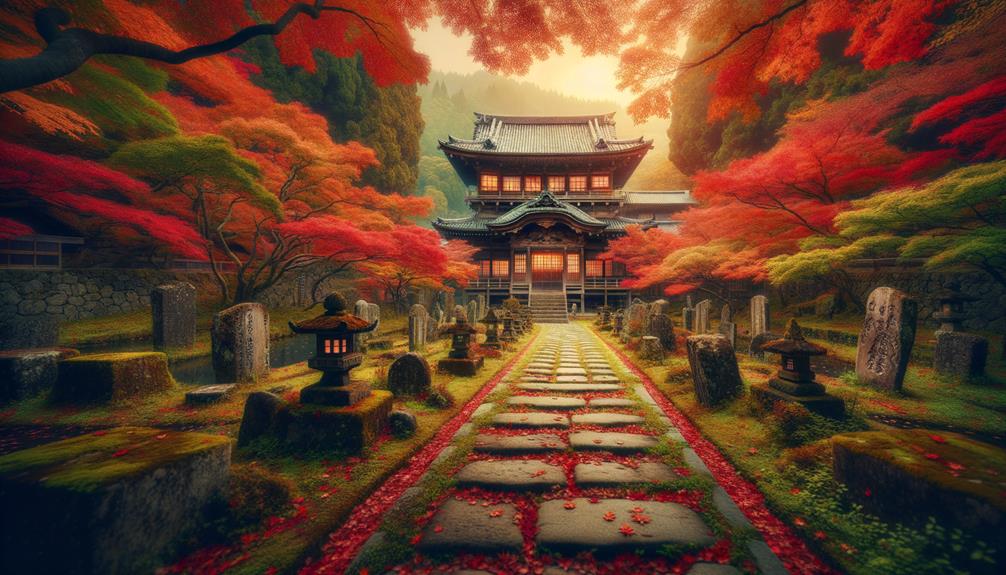
The Aoba Castle Site Museum, founded by the legendary Masamune Date, offers a fascinating glimpse into the samurai era with its impressive collection of armor, swords, and historical artifacts. Stepping into the museum, I was immediately drawn to the iconic statue of Masamune Date on horseback. It's a powerful representation of the man who established the Sendai Domain and left an indelible mark on Japanese history.
As I wandered through the exhibits, I felt a deep connection to the past. The meticulously crafted samurai armor and elegantly forged swords spoke volumes about the skill and dedication of the artisans. Each artifact seemed to whisper tales of honor, bravery, and the tumultuous times the samurai endured.
The Castle Ruins surrounding the museum provided a fitting backdrop, reminding me that these artifacts once belonged to real warriors who walked these very grounds. The Date Bushotai re-enactors added an engaging touch, sharing vivid stories and historical insights that brought the samurai era to life.
Exploring the museum was like stepping back in time. It allowed me to appreciate the rich cultural heritage of the region and the enduring legacy of the samurai spirit.
Nearby Trails

When I left the museum, I immediately noticed the nearby trails calling out for adventure. The Aobayama-Kouchi trail, stretching a scenic 4.8 km, seemed ideal for a longer hike. For a quicker, more peaceful walk, the shorter Yoheenuma Pond trail caught my eye. Each path, from the historic Zuihōden Temple route to the picturesque Mikamine Promenade, offered its own unique view of Sendai's natural beauty and cultural heritage.
Popular Hiking Routes
While wandering around the trails near the Sendai Castle Ruins, I found that each path offers its own mix of natural beauty and historical intrigue. The area is a hiker's dream, full of vibrant greenery and echoes of Japan's rich past. Here are some trails that stood out:
- Aobayama-Kouchi Trail
- This 4.8 km trail takes about 1 hour and 25 minutes to hike. It winds through peaceful forested areas with a thick canopy overhead. You'll catch occasional glimpses of the ancient walls of Sendai Castle, making for a refreshing trek.
- Hotaru no Sato Trail
- At 3.7 km and roughly 1 hour and 2 minutes to complete, this trail is ideal for those who enjoy seeing fireflies on summer nights. The path is charming, with serene ponds and gentle slopes.
- Yoheenuma Pond Trail
- This is a short 1.4 km trail, taking just 18 minutes to walk. The highlight is Yoheenuma Pond, a picturesque spot that feels like a hidden gem amidst the city's hustle and bustle.
- Zuihōden Temple Trail
- Spanning 1.8 km and taking around 32 minutes, this trail leads to the impressive Zuihōden Temple, the mausoleum of Date Masamune. It offers both spiritual and historical rewards.
Each route provides a unique way to experience the beauty and history surrounding the Sendai Castle Ruins.
Scenic Walking Paths
Walking along nearby trails like the Hirose River path or the Aobayama Loop, I'm always amazed by how natural beauty and cultural heritage come together. Each step on the 4.3 km Hirose River trail offers peaceful views of the river, surrounded by lush greenery. It's a great way to take a break from the usual routine. The soft sounds of the river make it a calming experience, encouraging me to slow down and enjoy the moment.
The Aobayama Loop, at 2.3 km, has its own unique appeal. As I walk, I feel a connection to the rich history of Sendai Castle. The path winds through areas once visited by samurai, and it's easy to picture the castle's past glory as you're surrounded by old trees and seasonal flowers.
Other trails like Aobayama-Kouchi and Hotaru no Sato offer a changing landscape—from dense forests to open fields, each with its own story. Whether it's the short 18-minute Mikamine Promenade or the longer 4.8 km Gongenmori-Gyuukatsuji trail, there's always something new to see and think about. Here, nature and history come together, offering a unique walking experience.
Historical Trail Highlights
Often, I find myself drawn to the mix of history and nature along the trails near the Sendai Castle Ruins. These paths offer a unique experience, blending the area's rich cultural history with its natural beauty. Here are four trails you shouldn't miss:
- Aobayama-Kouchi: This trail meanders through the scenic greenery around Tohoku University. The peaceful academic setting combined with the natural surroundings makes for an inspiring walk.
- Hotaru no Sato: Known as the 'Village of Fireflies,' this trail is especially enchanting in the summer when fireflies illuminate the night. It's like stepping into a fairy tale.
- Yoheenuma Pond: A serene spot, this pond reflects the surrounding landscape beautifully. It's perfect for quiet reflection and photography, capturing Sendai's natural charm.
- Zuihōden Temple: This trail takes you to the resting place of Date Masamune, the founder of Sendai. The temple's architecture and historical significance offer a deep connection to the past.
Each trail provides a unique perspective, combining the historical essence of Sendai Castle with the stunning natural scenery.
Visitor Tips

When you visit the Sendai Castle Ruins, make sure to wear comfortable shoes since you'll be walking on both ancient stone paths and modern walkways. Also known as Aoba Castle, the site offers a unique mix of history and contemporary design, perfect for a relaxed exploration.
The panoramic views of Sendai city from the ruins are absolutely stunning. Standing at the stronghold of Date Masamune, the legendary samurai lord from the Edo period, you can really sense the historical significance. The original foundations and the war dead shrine serve as solemn reminders of the past, inviting a moment of reflection.
As you wander the well-kept grounds, you'll notice how traditional design blends seamlessly with modern amenities. There are guided tours available that provide a lot of information, but I personally enjoyed exploring at my own pace and soaking up the cultural atmosphere. Public transport makes it easy to get there, so you won't have any trouble accessing the site.
For families, the area is friendly and safe, making it a great spot for a relaxed day out. Don't forget to bring a camera to capture the essence of this historic gem.
Cultural Experiences
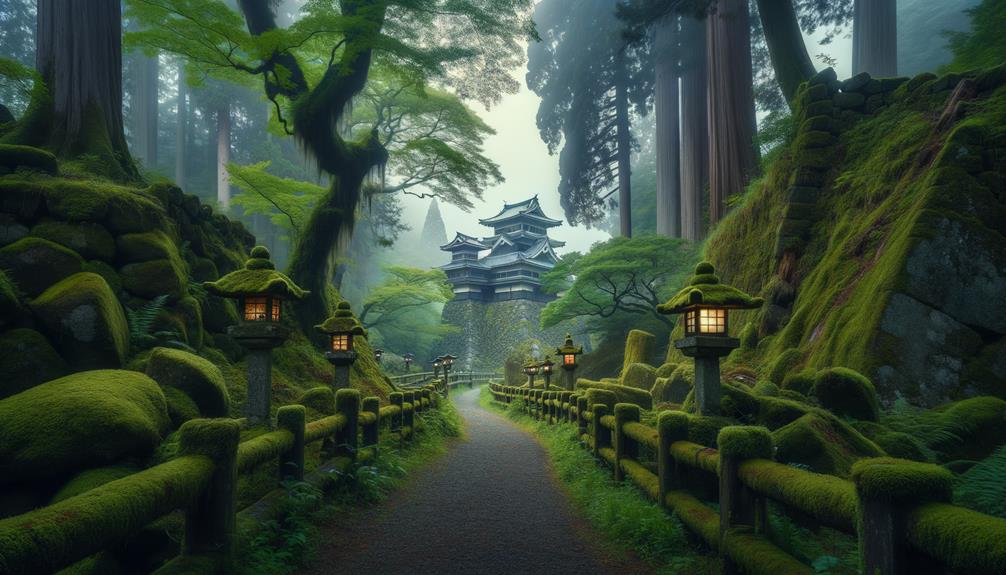
Checking out the cultural experiences at Sendai Castle Ruins, I was amazed by the deep history woven into every part of this ancient site. The Essence of Date Masamune Tour took me on a detailed journey from Zuihoden Mausoleum to Sendai Castle Ruins, sharing stories that made history feel real.
Here are four cultural highlights that left an impression:
- Date Masamune's Legacy: The tour showcased the lasting impact of Date Masamune, the founder of Sendai. His influence is everywhere, from statues to the stories shared by our well-informed guide.
- Zuihoden Mausoleum: Starting at this stunning resting place, I was captivated by the detailed architecture and vibrant colors that reflect the grandeur of the Date clan.
- Panoramic Views: Standing on the castle grounds, I looked out over Sendai City and imagined the strategic importance of this spot. The view offered a peaceful contrast to the busy city below.
- Interactive Learning: The guide's use of materials and engaging storytelling made the history come alive, turning facts into vivid stories.
The tour's year-round availability and easy access by the LOOPLE Sendai bus made it a hassle-free, enriching experience. Payment was straightforward, and the provided insurance gave added peace of mind. This walk through Sendai Castle is more than just a stroll; it's a deep dive into Japan's rich past.
Frequently Asked Questions
How Much Does It Cost to Go to the Sendai Castle?
Visiting Sendai Castle will set you back 2,500 JPY per person. The ticket includes a guided tour, which is a fantastic way to dive into the rich history and culture of the place. Totally worth it!
What Happened to Sendai Castle?
Sendai Castle used to be a strong symbol of power, but now it stands as a testament to resilience. While most of the original buildings were destroyed, the remaining foundations and the sweeping views of Sendai offer a peaceful reflection on history and culture.
How Do I Get to Aoba Castle?
To visit Aoba Castle, I took the Loople sightseeing bus from Sendai Station. Alternatively, you can enjoy a scenic 25-minute walk from International Center Station. The journey itself felt like a prelude to history.

